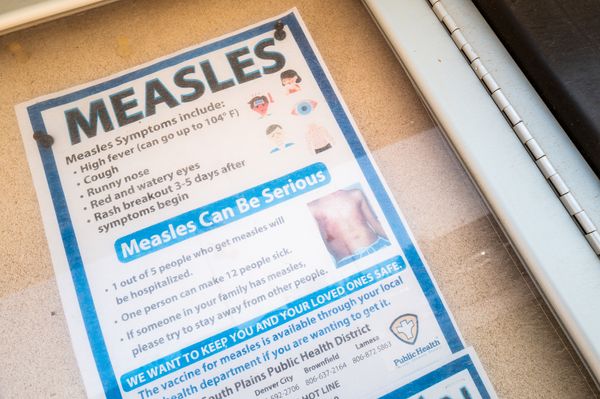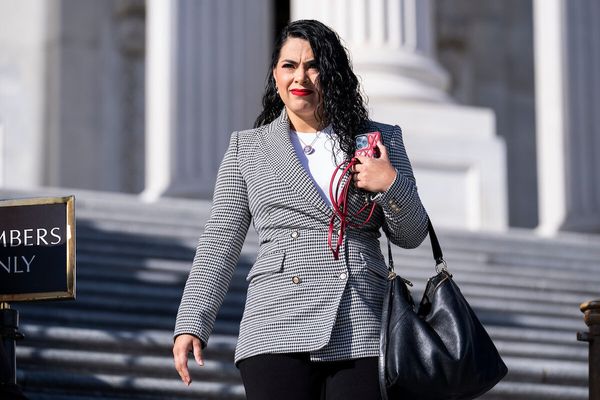
In March 2020, with the coronavirus pandemic raging, Dan Bane, then CEO of Trader Joe’s, sent a letter to the popular grocery chain’s employees. He blamed union advocates for driving discontent among workers and dismissed potential organizing actions as a “distraction,” suggesting that unions were spreading misinformation and fear.
Bridget Arend, a worker at the Essex Crossing Trader Joe’s store in New York City’s lower Manhattan, found the timing and substance of the letter appalling. She and many of her coworkers wanted to unionize — not because they were victims of sinister manipulation but because they worried about unsafe working conditions and were fed up with the vast power asymmetry in determining compensation and benefits, she said. “It didn’t feel like they were willing to lose even one day of profit to make sure that we could all go get tested and not spread [the coronavirus],” Arend told Capital & Main.
Four Trader Joe’s stores have unionized across America in the past few years, though Arend’s location is not yet one of them. While a majority of workers at the Essex Crossing store supported the union in a signature drive, the result of the election was a tie vote, 76-76.
But the workers may get their union anyway, thanks to the landmark 2023 Cemex decision by President Joe Biden’s National Labor Relations Board. That decision underscores the high stakes of the current presidential race for the prospects of worker organizing in America.

GOP presidential candidate Donald Trump and his running mate, Sen. JD Vance, have recently tried to woo unions and working-class voters, but Cemex is just one of several consequential rulings by the Biden-era NLRB that would likely be reversed if Trump wins in November.
Under Cemex, companies that commit unfair labor practices in the run-up to an election — such as holding mandatory anti-union meetings or retaliating against pro-union workers — can now be ordered to recognize the union and begin bargaining with it. On September 17, the NLRB’s Region 2-Manhattan office issued a complaint and notice of hearing in a case against Trader Joe’s in Manhattan and sought a bargaining order based on the Cemex ruling. The NLRB complaint alleges a range of unfair labor practices. Trader Joe’s did not respond to a request for comment from Capital & Main.
Beyond Cemex, legal scholars, labor law attorneys and union leaders anticipated that American workers would lose a broad range of labor rights and protections under a second Trump administration. Trump’s own record as president also suggests that during a second term, key positions in the NLRB would likely be filled by staff members hostile to unions, and the agency itself would be hampered by severe underfunding. “It would be a CEO’s dream and a worker’s nightmare,” Liz Shuler, president of the AFL-CIO, the largest federation of unions in America, told Capital & Main. The Trump campaign did not respond to a request for comment.
Whichever candidate wins in November, the authority of the NLRB to enforce labor law in America could diminish or even disappear if a new set of legal challenges to its constitutionality are successful.
Trump’s Anti-Union Record
Perhaps the strongest indication of how workers seeking to organize would fare under a second Trump administration is the former chief executive’s record during his first administration. During Trump’s term, the NLRB — a quasi-judicial body with up to five members appointed by the president — acted on all 10 items in a 2017 corporate wishlist from the U.S. Chamber of Commerce, according to a report by the Economic Policy Institute, a nonprofit nonpartisan think tank. The decisions made it easier for employers to fire or discipline employees, weakened rules to streamline union elections and restricted where and how workers can discuss workplace issues.
The Trump board also proposed a rule that would have excluded graduate students from the category of employees. Under current board Chair Lauren McFerran, a Biden appointee, the proposed rule was withdrawn, protecting the right of student workers to organize. Since 2022, more than 44,000 student workers across the country have formed unions. “It’s certainly possible that they would resurrect that effort and try to take collective bargaining rights away from graduate students,” said Sharon Block, professor of practice and executive director of the Center for Labor and a Just Economy at Harvard Law School and an NLRB member under President Barack Obama.
Seth Goldstein, an attorney at Julien, Mirer, Singla & Goldstein, which represents the Trader Joe’s United union, was more pessimistic. “I think student organizing would be dead,” he said.
Another important action by the Biden-era NLRB reversed the Trump board’s decision on the issue of “joint-employer” status. Some companies shield themselves from liability for labor law violations and the requirement to negotiate with unions by claiming that a subcontractor is the legal employer of workers, even if both companies in fact determine wages and working conditions. Trump’s NLRB made it harder for firms to be considered joint employers, but Biden’s board has taken the opposite approach. Just this month, NLRB Region 31 in Los Angeles ruled that Amazon is a joint employer with its delivery service providers, which could enable the Teamsters to bring the corporate giant to the bargaining table.
The NLRB under a second Trump term would likely reverse current decisions on these and many other issues, allowing employers to delay union elections, fire pro-union workers, more easily misclassify employees as independent contractors and fail to pay remedies to workers harmed by employer violations, all of which occurred under the Trump-era NLRB. “They would reverse all the things that the Biden board had in place,” Adam Shah, director of national policy at the workers’ rights advocacy group Jobs With Justice, told Capital & Main.
Underfunding the Protection of Workers’ Rights
Though the number of full-time employees at the NLRB declined especially quickly during the Trump administration, funding for the agency in the past decade has declined in real dollars under Democratic administrations as well. In 2010, the agency had 1,632 full-time employees; by 2024, the number was 1,258, according to an EPI report.
This decreasing capacity coincides with a period of exploding interest in unions among American workers and growing public enthusiasm for unions. A Gallup poll released in August 2023 found support for unions in 2022 at its highest level since 1965, though that support slipped in 2023. Meanwhile, the NLRB has seen surging caseloads, with increases in both election petitions and unfair labor practice charges in fiscal years 2022, 2023 and the first half of 2024.
“We’re honestly today at a real crisis point, because we’re operating with that [low] level of staff, but with a huge increase in caseload, which the Trump administration really kind of set in motion,” said Michael Bilik, national chair of the legislative committee of the National Labor Relations Union, which represents attorneys, investigators and administrative professionals in NLRB field offices.
This has affected morale at the agency, Bilik said. He recalled a “crushing weight of doom” among staff at the NLRB under the Trump administration, when early buyouts and refusals to transfer locations created vacancies that were never filled. Understaffing also means that workers must wait longer for cases to be addressed: The average disposition time in unfair labor practice cases was 124.2 days in fiscal year 2023, compared to 84.4 days the previous year, according to Bilik.
“A lot of NLRB agents and attorneys tell me about their caseloads and how they’ve increased what to them feel like orders of magnitude in the last several years,” said Joseph D. Richardson, a former NLRB field attorney.
In a statement to Capital & Main, NLRB General Counsel Jennifer A. Abruzzo said the agency’s case intake “reflects a critical moment in our nation’s history” and called on Congress “to fully fund the NLRB to effectively and efficiently comply with our Congressional mandate.”
Challenging the NLRB’s Constitutionality
Trump’s strategy of underfunding an agency crucial to workers rights isn’t new: Republican-led proposals to defund the NLRB date back more than a decade.
But Trump’s frequent attacks on what he calls the “deep state” have recently found a counterpart in a novel legal strategy that questions the constitutionality of the NLRB itself.
In January, the NLRB issued a complaint against SpaceX for the wrongful termination of eight former employees who alleged they were fired after advocating for better working conditions. SpaceX — whose CEO, Elon Musk, recently endorsed Trump and could be tapped by the former president for a major role in a second administration — responded by suing the NLRB the next day in a U.S. District Court in Texas.
Because the NLRB relies on administrative law judges who cannot be fired by the president, SpaceX argued that the insulation of such judges from presidential removal violated a much-debated section of Article II of the Constitution. It also claimed that the ability of such judges to issue penalties violated the Seventh Amendment’s right to a trial by jury. If successful, the challenges would overturn almost a century of legal and political precedent. “If the powers of the NLRA become unconstitutional, then labor law would really end right there,” Goldstein said. Amazon and Trader Joe’s have advanced similar arguments in the wake of the SpaceX case.
In May, a federal appeals court granted a temporary freeze on the proceedings of the NLRB case against SpaceX.
Kayla Blado, spokesperson for the NLRB, said that the agency is already seeing copycat arguments by a handful of other companies around the country. Earlier this month, a Trump-appointed judge granted an injunction to a tech company arguing that the NLRB is unconstitutional.
A June Supreme Court decision on the authority of another federal agency, the Securities and Exchange Commission, found that its attempt to impose penalties violated a plaintiff’s Seventh Amendment rights. While it’s unclear whether the Supreme Court would apply the same argument to the NLRB, it’s a distinct possibility — especially given the scaling back of regulatory agencies’ authority in the wake of Trump’s high court appointments. “We’re in uncharted territory now. So it’s definitely a nonzero chance,” said Harvard’s Block.







